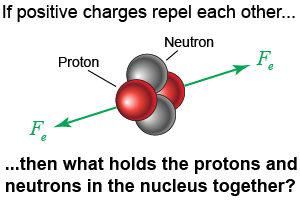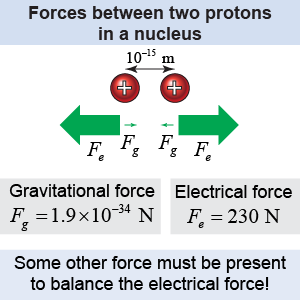|
 The nucleus of the atom contains both protons and neutrons. Protons are positively charged and neutrons do not have any charge. The coulomb repulsion between protons as close together as they are in a nucleus is enormously strong and should tear the nucleus apart instantly. Why does the nucleus stay together? The fact that atomic nuclei are stable implies that another type of force must exist that is attractive and much stronger than the coulomb force.
The nucleus of the atom contains both protons and neutrons. Protons are positively charged and neutrons do not have any charge. The coulomb repulsion between protons as close together as they are in a nucleus is enormously strong and should tear the nucleus apart instantly. Why does the nucleus stay together? The fact that atomic nuclei are stable implies that another type of force must exist that is attractive and much stronger than the coulomb force. 
|
Evidence for the strong nuclear force
|
When Rutherford discovered in 1909 that the nucleus of the atom was tiny and had positive charge, the evidence shed no light on whether the nucleus had any structure or was one particle. In 1918, Rutherford discovered the proton by observing that hydrogen atoms are sometimes produced when nitrogen atoms are bombarded with alpha particles. A hydrogen nucleus contains a single proton. In 1932, James Chadwick discovered another electrically neutral elementary particle called the neutron and measured its mass to be nearly the same as the proton. Physicists then knew that there were individual protons and neutrons in the nucleus. They were then faced with the problem of what holds the nucleus together? 
|

| The primary evidence for the existence of a strong nuclear force is that otherwise the nucleus would immediately disintegrate from the powerful repulsion of positively charged protons. Since we observe that many nuclei do not fly apart, we deduce there must be a strong force attracting protons and neutrons. This force is called the strong nuclear force and it is a short-range attractive force acting between protons and neutrons (but not electrons). Modern particle physicists usually refer to the strong nuclear force as the strong interaction. Of course, knowing a force exists does not explain what causes the force! The next step in the development of nuclear physics was to develop a theory to explain the strong force. |

 |
In the physical world, there are four fundamental forces that govern the behavior of everything from the motion of planets to the motion of atoms. These forces are gravity, electromagnetism, the strong nuclear force, and the weak nuclear force. You are already familiar with the first two, as they visibly affect people in their daily lives. But we cannot directly see the effects of strong and weak nuclear forces, because they are short range; their influence only extends between atoms or, in the case of the strong force, within the nucleus of atoms. Fields of gravity and electromagnetism are infinite and can cause effects over great distances, such as between the Sun and the Earth. Although the nuclear forces are very strong, their effects drop off quickly with distance.
Gravity, electromagnetism, and the strong and weak nuclear forces are the four fundamental forces that govern the behavior of everything in the universe. 
|
In 1935, Japanese theorist Hideki Yukawa proposed a model in which the strong force would work through a hitherto unknown type of massive, elementary particle called the meson. Yukawa named his predicted particles after the Greek word mesos (μέσος)—which means “intermediate”—for the role mesons play in mediating the strong force. Experimental confirmation of Yukawa’s theory came in 1947 when an international team led by English physicist Cecil Power discovered the first meson, a pi meson (or pion). 
|
The strong interaction not only binds the atomic nucleus together, it also governs the interactions among quarks, the elementary particles from which protons and neutrons are made. The existence of quarks was independently proposed by Murray Gell-Mann and George Zweig in 1962. The first quark was experimentally confirmed in 1968 at the Stanford Linear Accelerator Center, providing additional evidence for the strong interaction and the theory behind it. 
 |
Today we know that protons and neutrons are made of even smaller particles, known as quarks. A proton is made from two up quarks and one down quark. A neutron is made from two down quarks and a single up quark.
When Murray Gell-Mann first proposed his theory that included subatomic particles smaller than protons or neutrons, he had a pronunciation in mind, “kwork.” In perusing the book Finnegans Wake by James Joyce, Gell-Mann came across three lines that provided a different spelling for his new particles: Three quarks for Muster Mark!
Sure he has not got much of a bark
And sure any he has it’s all beside the mark. Joyce appeared to be using the word “quark” to refer to a sound made by gulls. The name and the spelling subsequently became widely adopted in nuclear physics. 
|
Who discovered the strong nuclear force?
 |
No one scientist can be credited with a single “discovery” of the strong nuclear force. Many different pieces of evidence and explanations played a role in the development of the concept of the strong nuclear force, including Rutherford’s discovery of the proton and Chadwick’s discovery of the neutron, Yukawa’s prediction of the pi meson and Power’s discovery of it, and Gell-Mann and Zweig’s prediction of the quark and its subsequent discovery. 
|

